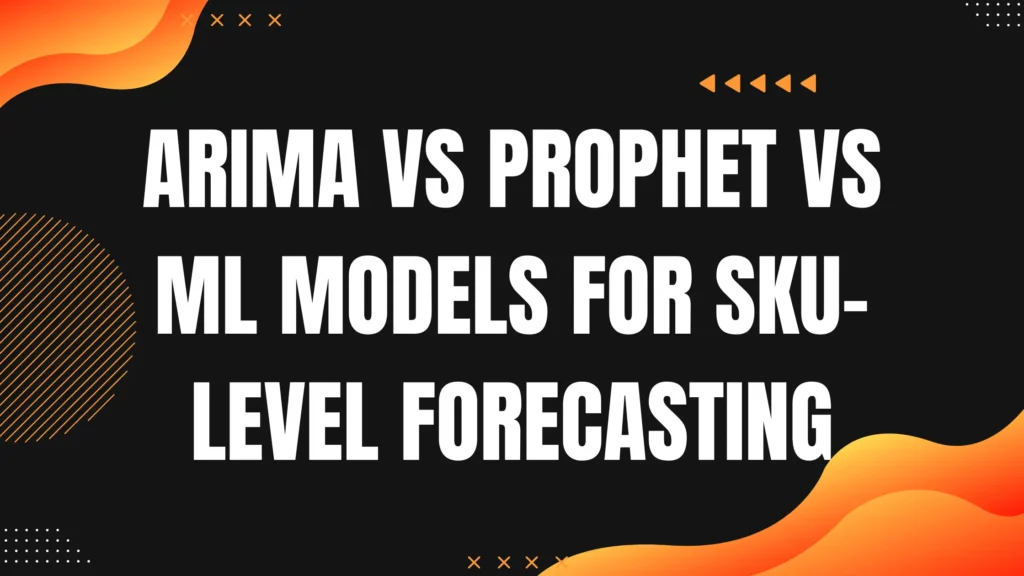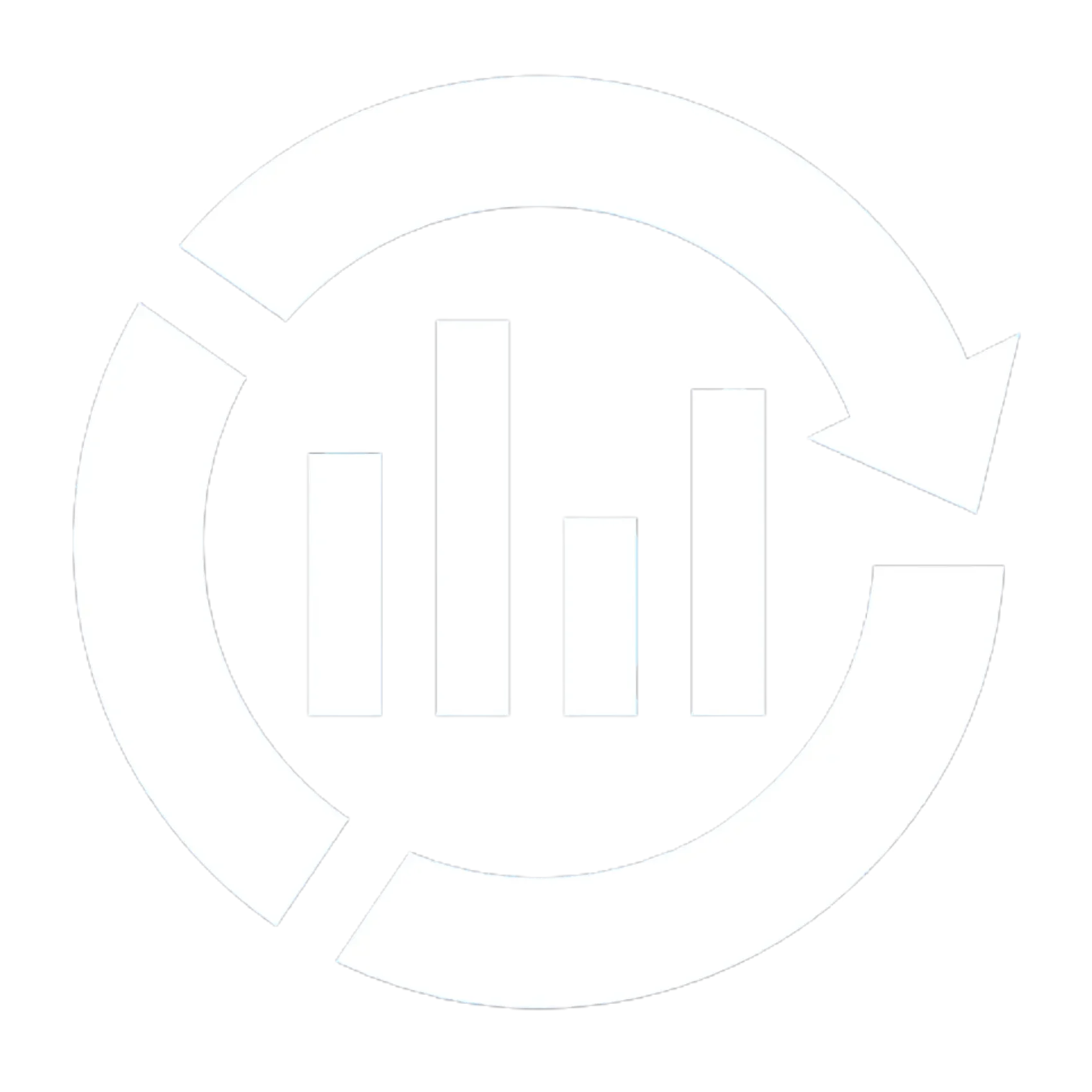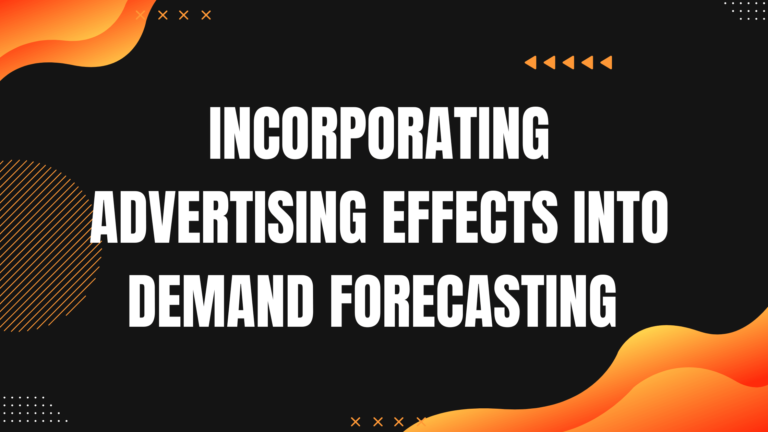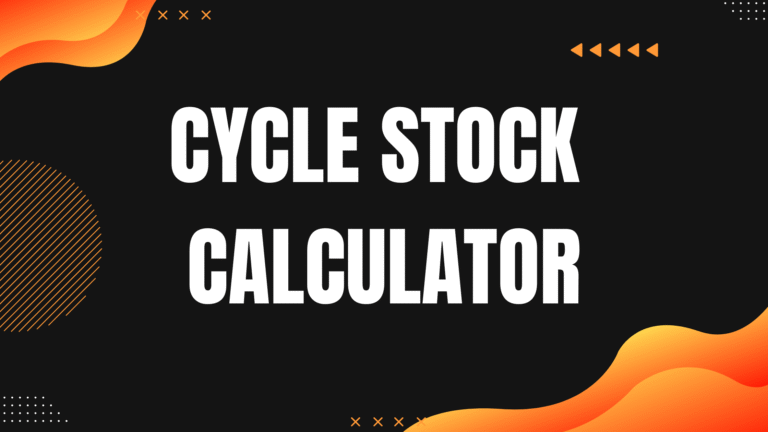Struggling to decide whether ARIMA, Prophet, or Machine Learning (ML) is the right forecasting approach for your SKUs? You’re not alone. In supply chain analytics, SKU-level forecasting is one of the toughest challenges—demand variability, promotions, seasonality, and short product life cycles create constant uncertainty. The model you choose can directly influence inventory efficiency, working capital, and service levels. Get it wrong, and you risk stockouts that erode customer trust or overstocks that lock up capital and inflate carrying costs.

In this guide, we’ll break down ARIMA, Prophet, and ML models, compare them on real-world factors like interpretability, accuracy, and scalability, and show you how to choose the right fit for your supply chain.
Why SKU-Level Forecasting Matters
Unlike aggregate forecasting at the category or regional level, SKU-level forecasting zooms in on the most granular unit: individual products. This level of detail is essential because each SKU behaves differently, with its own demand curves, seasonality, and sensitivity to price or promotions.
A poor forecast on a single SKU—say, a top-selling detergent size—can ripple through the entire supply chain. Stockouts frustrate customers and damage brand loyalty, while overstocks quietly drain cash and inflate holding costs. The impact of even one miscalculated SKU can outweigh mistakes at broader levels.
Accurate forecasting also enables smarter promotional planning. When businesses can anticipate how discounts or marketing campaigns affect demand at the SKU level, they avoid stock imbalances, reduce waste, and maximize the lift from their campaigns.
Perhaps most importantly, SKU-level forecasting safeguards working capital efficiency. Overestimating slow-moving products ties up cash that could fuel growth elsewhere, while underestimating fast movers directly erodes revenue. Choosing the right forecasting model—whether a traditional statistical approach or a modern machine learning algorithm—becomes the deciding factor between a supply chain that runs lean and one that bleeds margins.
Related Reads: Predictive Analytics in Supply Chain: 2025 Benefits & Trends
ARIMA: The Old Guard of Time Series
ARIMA, or AutoRegressive Integrated Moving Average, is one of the most established forecasting techniques. It has stood the test of time and remains a dependable option for many supply chain teams working at the SKU level.
Its appeal lies in simplicity and interpretability. ARIMA works well when short-term demand is steady and patterns such as seasonality or trends are easy to spot. It also performs with relatively little historical data—one or two years of records can often be enough. Because the model’s structure is transparent, you can usually explain why a forecast looks the way it does, which helps win stakeholder confidence.
The limitations show up when the environment gets more dynamic. ARIMA requires manual parameter tuning, a task that quickly becomes impractical when forecasting thousands of SKUs. It struggles with sudden demand spikes, like flash sales or viral product surges, and it does not easily account for external drivers such as promotions, holidays, or price shifts.
In short, ARIMA is best suited for stable, mature SKUs with consistent demand patterns. When volatility is low and predictability is high, it still delivers reliable forecasts without unnecessary complexity.
Prophet: Facebook’s Forecasting Workhorse
Prophet, developed by Facebook (now Meta), was designed to make forecasting accessible for businesses that need accuracy without heavy statistical expertise. It has become popular in retail and e-commerce because it balances automation with practicality.
One of Prophet’s biggest strengths is its ability to handle seasonality automatically. Weekly peaks, yearly holiday surges, and even custom events like Black Friday can be incorporated into forecasts with minimal effort. It is also resilient to messy data: missing days, irregular sales records, or outliers don’t easily throw it off. This makes it especially useful for SKU-level forecasting where data gaps are common. Scaling Prophet across hundreds or even thousands of products is much easier than manually tuning traditional models.
Still, Prophet has its trade-offs. It can sometimes oversimplify demand patterns, smoothing over sudden spikes or dips that matter in highly volatile SKUs. While it captures seasonality well, it is less effective when external factors such as aggressive promotions or competitor moves drive demand. In those situations, forecasts may lag reality.
Prophet works best for products with clear, recurring seasonal trends—think beverages that peak in summer or retail items that surge during the holidays. For businesses that want a relatively low-effort model that still accounts for seasonality and scales across many SKUs, Prophet often strikes the right balance.
Machine Learning Models: The Data-Hungry Powerhouse
Machine learning (ML) has transformed forecasting by going beyond traditional time-series patterns. Instead of relying only on past sales, ML models can factor in a wide range of variables—price changes, promotions, competitor activity, weather, or even social media signals—to predict demand at the SKU level.
The biggest strength of ML lies in its flexibility and ability to capture complex, non-linear relationships that statistical models often miss. With enough data, algorithms such as Random Forests, XGBoost, or deep learning models like LSTMs can uncover subtle drivers of demand and adapt quickly to changing conditions. For companies managing large SKU portfolios across multiple regions, ML models can scale efficiently and deliver highly accurate forecasts.
The catch is that ML thrives only when fed with rich, high-quality data. Building and maintaining these models requires engineering support, careful feature selection, and ongoing monitoring. Unlike ARIMA or Prophet, ML models are often less interpretable, which can make them feel like a “black box” to business users who want clear explanations.
In practice, ML models are best suited for high-volume SKUs where demand is influenced by many external factors and historical patterns alone aren’t enough. When volatility is high, and when promotions or pricing shifts are critical, ML usually outperforms traditional forecasting methods—provided the data foundation is strong.
Advanced Comparison: ARIMA vs Prophet vs Machine Learning Models for SKU-Level Forecasting
| Dimension | ARIMA (Statistical Classic) | Prophet (Automated & Seasonal) | Machine Learning Models (XGBoost, LSTM, etc.) |
|---|---|---|---|
| Ease of Use | Requires manual parameter tuning (p, d, q). Technical expertise needed. | Plug-and-play with automated seasonality handling. Minimal tuning. | Moderate to hard. Needs data science and engineering support. |
| Data Requirements | Low. Works with 1–2 years of clean historical sales data. | Moderate. Prefers 2–3 years, especially for seasonal accuracy. | High. Needs large datasets with features beyond sales (promotions, pricing, external signals). |
| Interpretability | High. Transparent forecasts easy to explain to stakeholders. | Medium. Forecast logic is semi-transparent but less granular. | Low to medium. Often a “black box” unless paired with explainability tools (e.g., SHAP, LIME). |
| Scalability | Poor. Each SKU requires separate tuning. | Good. Can run across thousands of SKUs with limited manual effort. | Excellent. Can scale across large portfolios if infrastructure is in place. |
| Seasonality Handling | Manual. Needs custom adjustments for yearly or holiday effects. | Automatic. Handles weekly, yearly, and holiday patterns easily. | Learns patterns if seasonality features are engineered into the dataset. |
| Volatility Handling | Weak. Struggles with sudden spikes (e.g., flash sales). | Moderate. Smooths spikes but may underpredict fast shifts. | Strong. Captures non-linear demand shifts and reacts well to shocks (if trained properly). |
| External Variables | Limited. Hard to incorporate promotions, pricing, or weather. | Limited. Some flexibility but not designed for complex regressors. | Strong. Can include dozens of external factors to boost accuracy. |
| Accuracy Potential | Reliable in stable, predictable SKUs. | Strong in seasonal or moderately volatile SKUs. | Highest when data is rich, SKUs are complex, and external drivers matter. |
| Cost & Maintenance | Low once set up, but manual upkeep at SKU scale is costly in time. | Low to moderate. Easy to deploy and maintain with business users. | High. Requires skilled teams, compute power, and ongoing retraining. |
| Best Use Case | Mature, stable SKUs with predictable patterns. | SKUs with strong seasonal demand or recurring patterns. | High-volume, volatile SKUs where external drivers (price, promo, events) are critical. |
Implementing ARIMA, Prophet, and ML Models in Python
If you are working in Python, you don’t have to start from scratch. Each of these forecasting approaches has well-established libraries that make implementation straightforward. Here’s how they look in practice at the SKU level.
ARIMA in Python
ARIMA models are available in the statsmodels library and are a good starting point when SKU demand is stable and follows consistent patterns.
import pandas as pd
from statsmodels.tsa.arima.model import ARIMA
# Load SKU sales data
data = pd.read_csv("sku_sales.csv", parse_dates=['date'], index_col='date')
y = data['sales']
# Fit ARIMA model (example: ARIMA(2,1,2))
model = ARIMA(y, order=(2,1,2))
fit = model.fit()
# Forecast next 10 periods
forecast = fit.forecast(steps=10)
print(forecast)
This approach is easy to explain and works with limited history, but tuning parameters for hundreds of SKUs can become time-consuming.
Prophet in Python
Prophet, created by Facebook, was designed to simplify business forecasting. It is available as the prophet package and automatically detects weekly, yearly, and holiday patterns.
from prophet import Prophet
# Prepare data for Prophet
df = data.reset_index()[['date','sales']]
df.columns = ['ds','y']
# Fit Prophet model
model = Prophet()
model.fit(df)
# Forecast next 10 periods
future = model.make_future_dataframe(periods=10)
forecast = model.predict(future)
print(forecast[['ds','yhat','yhat_lower','yhat_upper']].tail())
Prophet is beginner-friendly, less sensitive to missing data, and great for SKUs that show strong seasonal or holiday demand cycles.
Machine Learning Models in Python
For SKUs influenced by multiple drivers such as promotions, pricing, or weather, machine learning models offer far more flexibility. Libraries like scikit-learn and XGBoost can incorporate these features to capture non-linear relationships.
import pandas as pd
from sklearn.ensemble import RandomForestRegressor
# Example features: lagged sales, day of week, promotions
X = data[['lag_1','lag_7','promo_flag']]
y = data['sales']
# Train/test split
train_X, test_X = X[:-30], X[-30:]
train_y, test_y = y[:-30], y[-30:]
# Fit ML model
model = RandomForestRegressor(n_estimators=100, random_state=42)
model.fit(train_X, train_y)
# Forecast
predictions = model.predict(test_X)
print(predictions)
These models can deliver higher accuracy in volatile situations, but they require more engineering effort and high-quality datasets to perform well.
Which Python Approach Should You Use?
ARIMA in statsmodels is best for stable SKUs with predictable demand. Prophet in prophet works well when seasonality and holidays dominate the sales pattern. Machine learning models in scikit-learn, XGBoost, or even deep learning frameworks like TensorFlow are best for complex SKUs where external factors matter.
Many businesses adopt a hybrid approach: using ARIMA or Prophet for baseline forecasts and adding ML models to account for promotions or sudden shifts. In Python, this layered strategy can be automated across thousands of SKUs, striking the right balance between simplicity, scalability, and accuracy.
Conclusion
No single forecasting model is perfect for every SKU. ARIMA shines when demand is steady and patterns are predictable, making it a reliable option for mature products. Prophet is a strong middle ground—it automates seasonality detection, handles messy data gracefully, and scales well across large SKU portfolios. Machine learning models deliver the highest accuracy when data is rich and demand drivers are complex, but they come with higher costs, technical requirements, and lower interpretability.
The smartest approach is not to choose one model blindly but to segment your SKUs by behavior. Stable items may only need ARIMA, seasonal products thrive under Prophet, and highly volatile SKUs often demand the power of ML. Many companies even blend these methods into hybrid frameworks, using simpler models for baseline demand and machine learning for dynamic adjustments.
At the end of the day, SKU-level forecasting isn’t just about choosing a model—it’s about aligning the right technique with the right product, balancing accuracy that decision-makers can trust, and building a supply chain that’s both lean and resilient.
Frequently Asked Question (FAQ)
There’s no universal winner. ARIMA works well for stable SKUs with predictable patterns, Prophet is ideal for seasonal SKUs, and ML models excel when demand is complex and influenced by multiple external factors.
Yes. ML models generally require more historical sales data plus additional features such as pricing, promotions, and external signals. If data is limited, ARIMA or Prophet may be more practical.
Prophet often outperforms ARIMA when seasonality is strong and data is messy, but ARIMA can still be more accurate for short-term, stable demand without external shocks.
ARIMA and Prophet struggle to fully account for promotions or price changes. Machine Learning models, however, can incorporate these variables directly, improving forecast accuracy.
Yes. Many businesses use a hybrid approach—ARIMA or Prophet for baseline forecasts and ML models for dynamic adjustments during promotions, price changes, or volatile demand periods.
Segment your SKUs. Stable items are suited for ARIMA, seasonal items for Prophet, and volatile or promotion-driven items for ML. Matching models to SKU behavior usually delivers the best results.






